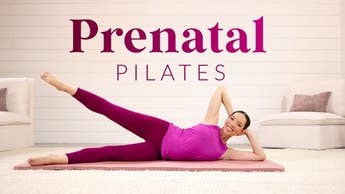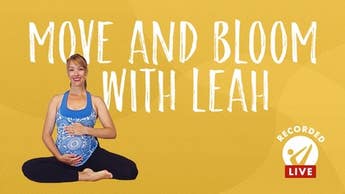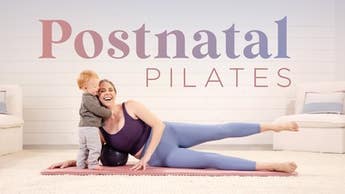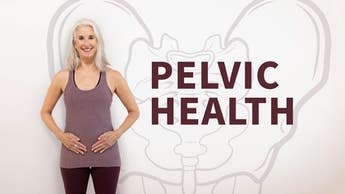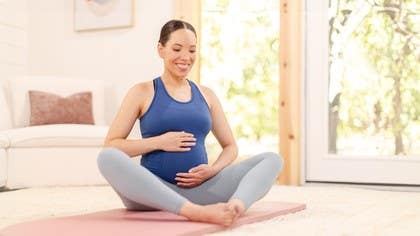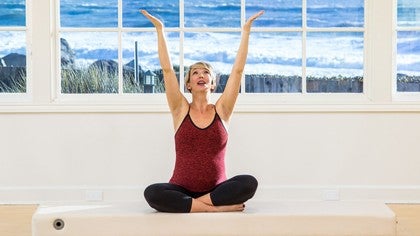Prenatal and Postnatal Pilates Guide
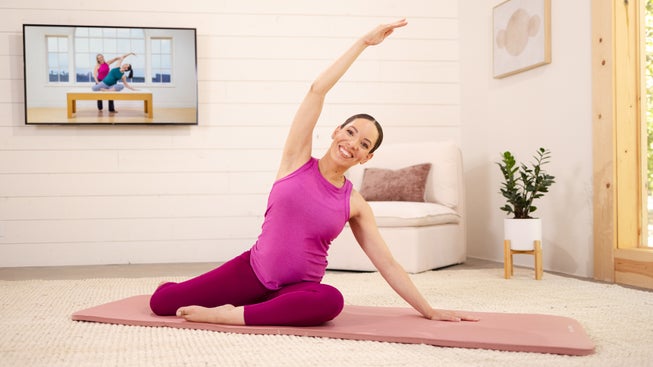
About Prenatal Pilates
Widely regarded as one of the best forms of exercise for pregnancy, prenatal Pilates is specifically designed to accommodate the needs of the expectant mother. Doing Pilates on equipment, such as the Reformer, or on the Mat can safely boost your physical and mental health. Due to its focus on improving stability and strengthening the entire body, practicing Pilates can prevent and offer relief from joint pain. Thanks to the focus on better posture, alignment, and body awareness, Pilates can help relieve sciatica, back and hip pain while alleviating symptoms of pubic synthesis, a common pregnancy condition.
Exercising during Pregnancy
Exercising during pregnancy is beneficial for both mom and baby alike! Recent studies share that regular exercise throughout the prenatal period can support the baby’s brain growth and development, among other benefits. As for mama, staying in shape while expecting has numerous advantages for her overall well-being, from easing pregnancy-related aches and pains to managing stress and preventing conditions like gestational diabetes and preeclampsia.
Benefits of Prenatal Pilates
Prenatal Pilates differs from “regular” Pilates due to its heightened focus on the transverse abdominis, the deep layer of muscles that “corset” the waist. Instead of increasing the strength of the abdominal contraction, the core connection becomes about building and reinforcing the support system. The Pilates method emphasizes deep breathing and the mind-body connection, which helps to prepare mothers for labor and childbirth. Furthermore, these factors help increase resolve, enabling women to better cope with the emotional ups and downs many experience during pregnancy.
First Trimester
Although it’s considered safe to maintain your regular workouts during the first few months of pregnancy, you might be feeling low-energy, fatigued, and/or nauseous. Take care not to overexert or overheat your body, and above all, don’t push yourself. In terms of your Pilates workouts, there’s nothing specific that you can’t do just yet, but it’s a good time to get educated on the modifications you may need throughout the duration of your pregnancy. Instead of trying to go up a level, revisit the basics within your Pilates foundation like breathing and stabilization. Love the Reformer? Be more moderate with your spring choice, choosing heavier resistance for stability exercises and lighter tension for arm and leg work.
Second Trimester
The second trimester is usually the time when moms-to-be feel most energetic during pregnancy. You may be tempted to push yourself, but it’s important to be aware that your weight and center of gravity are going through a period of flux, which can throw your balance and alignment off-kilter. To avoid injury and keep you feeling your best, start incorporating modifications to your Pilates workouts. For one, limit exercises done on your back (and especially forward flexion), which can compress the inferior vena cava and the aorta, making your feel dizzy. Additionally, it may be uncomfortable working out on your belly. Instead, opt for side-lying, seated or standing work, using supportive props when needed.
Third Trimester
You're almost there! Given that baby will be arriving soon, you are likely feeling tired again and possibly more anxious. In your third trimester, grant yourself more permission to relax—and breathe deeply—in your workouts. Standing exercises are great, but opt for a wider, turned-out stance to accommodate your belly. In addition to the belly, most women find that their breasts are growing, too, which can lead to back pain. Add some chest and back stretching and strengthening to counteract your newfound body alignment. If you feel any pain in your belly button as you move, that could signal a hernia, so it’s best to see your doctor right away.
Postnatal/Postpartum
Congratulations on your new baby! Caring for a newborn can be overwhelming, so self-care is of the utmost importance now. Postnatal Pilates can help prevent common postpartum issues, such as lower back pain and shoulder tension. Deep breathing in Pilates leads to more energy, mental clarity, and patience. Whether you’ve had a vaginal delivery or a C-section, Pilates can help accelerate the recovery process, making you feel calmer and more connected. Furthermore, the right Pilates exercises can also help heal diastasis recti, the excessive separation of the abdominals common in postpartum women.
Full-Body Prenatal and Postnatal Pilates
Frequently Asked Questions
Is prenatal Pilates safe?
Although it’s considered safe to maintain your regular workout regimen through the first trimester, starting prenatal Pilates right off the bat can be beneficial. A teacher trained in prenatal Pilates can educate you on the various modifications you need to make throughout the three trimesters, such as avoiding forward-flexion exercises that can cause diastasis recti, avoiding overstretching and using support props, ensuring you feel confident and safe as you move.
What changes should I expect during pregnancy?
As you progress through your pregnancy, your body goes through a series of changes, which can lead to fatigue and decreased sense of balance and endurance. Pilates is there to support you at every stage of your pregnancy, but it’s always important to let your body be your guide. Pregnancy is not a time to try to move up a level or advance in your Pilates practice. Move at your own pace, take breaks when needed, and always listen to your body.
What if I'm new to Pilates?
You can practice Pilates safely during pregnancy, even if you’ve never done it before! Prenatal Pilates differs from standard Pilates due to its focus on the transverse abdominis, the muscles that corset the waist. We recommend you consult a Pilates teacher to help guide you through the process and do your research. Make sure the teacher you choose is educated in prenatal Pilates and understands the pregnant body.
Is Reformer Pilates safe during pregnancy?
The Reformer is not only safe, it’s recommended! Opt for a heavier spring tension for stability exercises and lighter spring tension for leg and arm work. If you are not experienced on the Pilates Reformer, make sure to seek out a qualified prenatal Pilates instructor before hopping on.
Related Articles
Your Pilates Anytime Membership Benefits
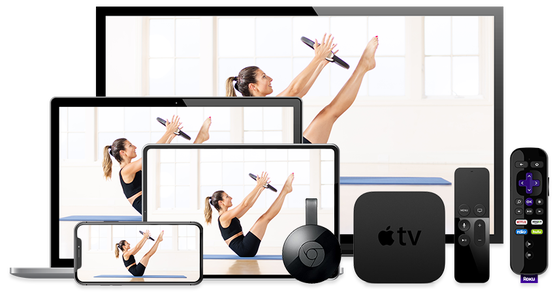
- 15-Day Free Trial
- Unlimited Access to Thousands of Classes
- 95+ Pilates Programs and Challenges
- No Ads
- New Videos Weekly
- Available on All Your Favorite Devices
